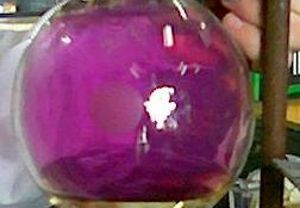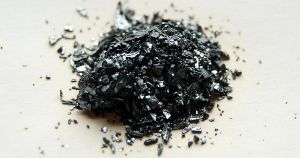The chemical element iodine is classed as a halogen and a nonmetal. It was discovered in 1811 by Bernard Courtois.

Data Zone
| Classification: | Iodine is a halogen and a nonmetal |
| Color: | bluish-black solid, purple vapor |
| Atomic weight: | 126.9045 |
| State: | solid |
| Melting point: | 113.5 oC, 386.6 K |
| Boiling point: | 184 oC, 457 K |
| Electrons: | 53 |
| Protons: | 53 |
| Neutrons in most abundant isotope: | 74 |
| Electron shells: | 2,8,18,18,7 |
| Electron configuration: | [Kr] 4d10 5s2 5p5 |
| Density @ 20oC: | 4.93 g/cm3 |
Reactions, Compounds, Radii, Conductivities
| Atomic volume: | 25.74 cm3/mol |
| Structure: | layers of I2 |
| Specific heat capacity | 0.214 J g-1 K-1 |
| Heat of fusion | 15.52 kJ mol-1 of I2 |
| Heat of atomization | 107 kJ mol-1 |
| Heat of vaporization | 41.57 kJ mol-1 of I2 |
| 1st ionization energy | 1008.4 kJ mol-1 |
| 2nd ionization energy | 1845.8 kJ mol-1 |
| 3rd ionization energy | 3184 kJ mol-1 |
| Electron affinity | 295.16 kJ mol-1 |
| Minimum oxidation number | -1 |
| Min. common oxidation no. | 0 |
| Maximum oxidation number | 7 |
| Max. common oxidation no. | 7 |
| Electronegativity (Pauling Scale) | 2.66 |
| Polarizability volume | 5 Å3 |
| Reaction with air | none |
| Reaction with 15 M HNO3 | mild, ⇒ HIO3 |
| Reaction with 6 M HCl | none |
| Reaction with 6 M NaOH | mild, ⇒ OI–, I– |
| Oxide(s) | I2O5, I4O9, I2O4 |
| Hydride(s) | HI |
| Chloride(s) | ICl, ICl3 |
| Atomic radius | 140 pm |
| Ionic radius (1+ ion) | – |
| Ionic radius (2+ ion) | – |
| Ionic radius (3+ ion) | – |
| Ionic radius (1- ion) | 206 pm |
| Ionic radius (2- ion) | – |
| Ionic radius (3- ion) | – |
| Thermal conductivity | 0.45 W m-1 K-1 |
| Electrical conductivity | 1.0 x 10-5 S m-1 |
| Freezing/Melting point: | 113.5 oC, 386.6 K |
Discovery of Iodine
Iodine was discovered by Bernard Courtois in 1811 in France.
Courtois was trying to extract potassium chloride from seaweed. After crystallizing the potassium chloride, he added sulfuric acid to the remaining liquid.
This, rather surprisingly, produced a purple vapor, which condensed into dark crystals. These were the first crystals of iodine ever made.
Courtois studied this new substance and found that it combined well with phosphorous and hydrogen, but it did not form compounds easily with carbon or oxygen.
He also discovered that when mixed with ammonia it formed a brown colored solid (nitrogen triiodide) that exploded at the slightest touch.
Iodine’s name comes from the Greek work ‘iodes’ meaning violet. Iodine’s purple vapor is shown below in a photo by Matias Molnar.



Iodine Crystals. Photo by Ben Mills.
Appearance and Characteristics
Harmful effects:
In small doses, iodine is slightly toxic and it is highly poisonous in large amounts. Elemental iodine is an irritant which can cause sores on the skin. Iodine vapor causes extreme eye irritation.
Characteristics:
Iodine is a bluish-black, lustrous solid. Although it is less reactive than the elements above it in group 17 (fluorine, chlorine and bromine) it still forms compounds with many other elements.
Although iodine is a non-metal, it displays some metallic properties.
When dissolved in chloroform, carbon tetrachloride or carbon disulfide, iodine yields purple colored solutions. It is barely soluble in water, giving a yellow solution.
Uses of Iodine
Iodine is important in medicine, in both radioactive and non-radioactive forms. Iodide and thyroxin, which contains iodine, are used inside the body.
A solution containing potassium iodide (KI) and iodine in alcohol is used to disinfect external wounds. Elemental iodine is also used as a disinfectant.
Silver iodide is used in photography.
Iodine is sometimes added to table salt to prevent thyroid disease.
Iodine’s other uses include catalysts, animal feeds and printing inks and dyes.
Abundance and Isotopes
Abundance earth’s crust: 450 parts per billion by weight, 73 parts per billion by moles
Abundance solar system: parts per billion by weight, parts per billion by moles
Cost, pure: $8.3 per 100g
Cost, bulk: $ per 100g
Source: In nature, iodine occurs in the form of iodide ions, mainly in seawater. It is introduced into the food chain via seaweed and other sea-plants. Iodine is found in some minerals and soils.
Commercially, iodine is obtained in several ways, such as taking iodine vapor from processed brine, by ion exchange of brine or by releasing iodine from iodate taken from nitrate ores.
Isotopes: 34 whose half-lives are known, with mass numbers 108 to 141. Naturally occurring iodine consists of the one stable isotope: 127I

References
Cite this Page
For online linking, please copy and paste one of the following:
<a href="https://www.chemicool.com/elements/iodine.html">Iodine</a>
or
<a href="https://www.chemicool.com/elements/iodine.html">Iodine Element Facts</a>
To cite this page in an academic document, please use the following MLA compliant citation:
"Iodine." Chemicool Periodic Table. Chemicool.com. 17 Oct. 2012. Web. <https://www.chemicool.com/elements/iodine.html>.
Hey there! I noticed a small error on the site regarding the electron configuration of Iodine. It should read: [Kr] 5s2 4d10 5p5 because the 4d energy level is filled before the 5p level. Hope I helped!
Hi Jessica, thanks for your comment. The configuration we’ve shown is actually correct. 🙂
The Convention
What I should say to start with is that we’ve followed a convention for electron configurations so that, if there are electrons present in orbitals, lower principal quantum numbers are always shown preceding higher principal quantum numbers in the configuration. This means that it doesn’t matter whether in a real atom the 5s has lower or higher energy than the 4d orbitals. We always write 4d before 5s.
In the case of iodine this convention actually does yield the correct electron configuration – although it may at first seem to disagree with the orbital energy levels shown in textbooks, which show the filling order for orbitals as:
1s
2s 2p
3s 3p
4s 3d 4p
5s 4d 5p
6s 4f 5d 6p
7s 5f 6d 7p
Why [Kr] 4d10 5s2 5p5 is Iodine’s Electron Configuration
If we apply the Aufbau principal to the orbitals above, we would predict that the 5s orbital, because it has lower energy than the 4d orbitals, will fill with electrons before the 4d orbitals do – as you’ve said.
In fact, when two electrons are present in the 5s orbital the energy of the 4d orbitals falls below the energy of 5s. Therefore, the correct configuration for iodine is [Kr] 4d10 5s2 5p5
The reason we don’t always get the result we’d expect from applying the Aufbau Principal to orbitals is that when real electrons begin to interact with one another, some shifts in orbital energy levels can take place.
Thanks for the interesting comment Jessica – it may be worth considering whether we continue to show configurations using the principal quantum number convention or whether we show the actual configuration, when it’s known. 🙂
hi i read this passage and i thought it was a great article I took 10 notes just from this little passage
Hi Jayden, thanks for your kind words. I’m glad the info was useful to you.
This was really helpful with my science project and in my book where I use this element as a posion! I took like 15 notes just from this!